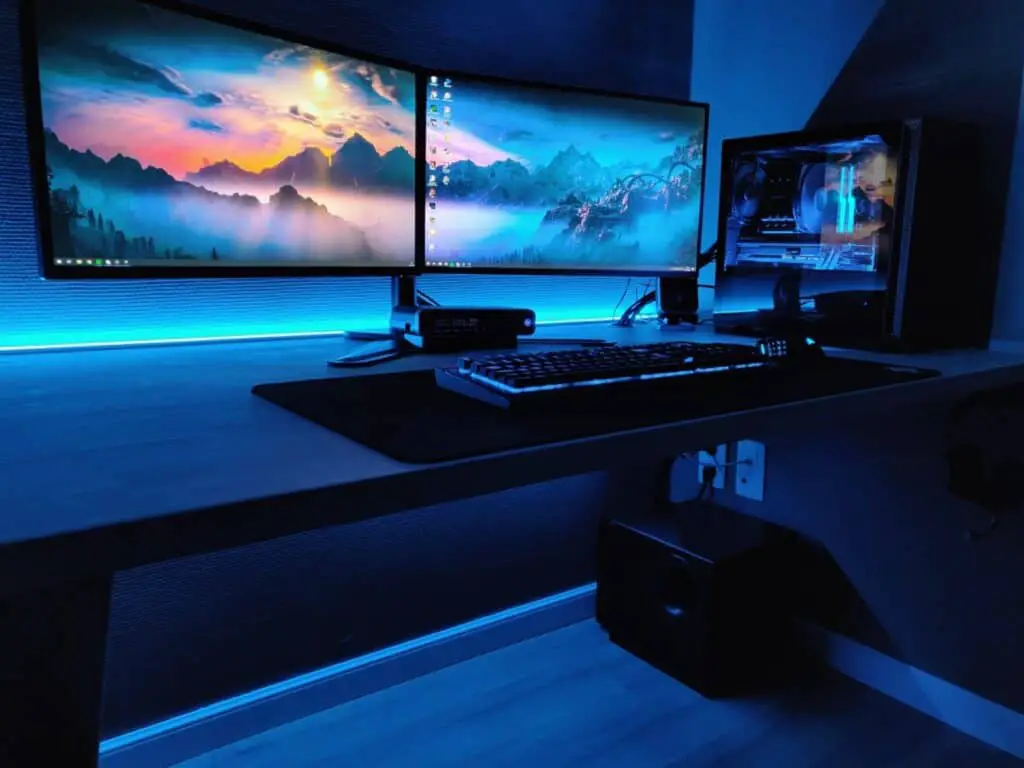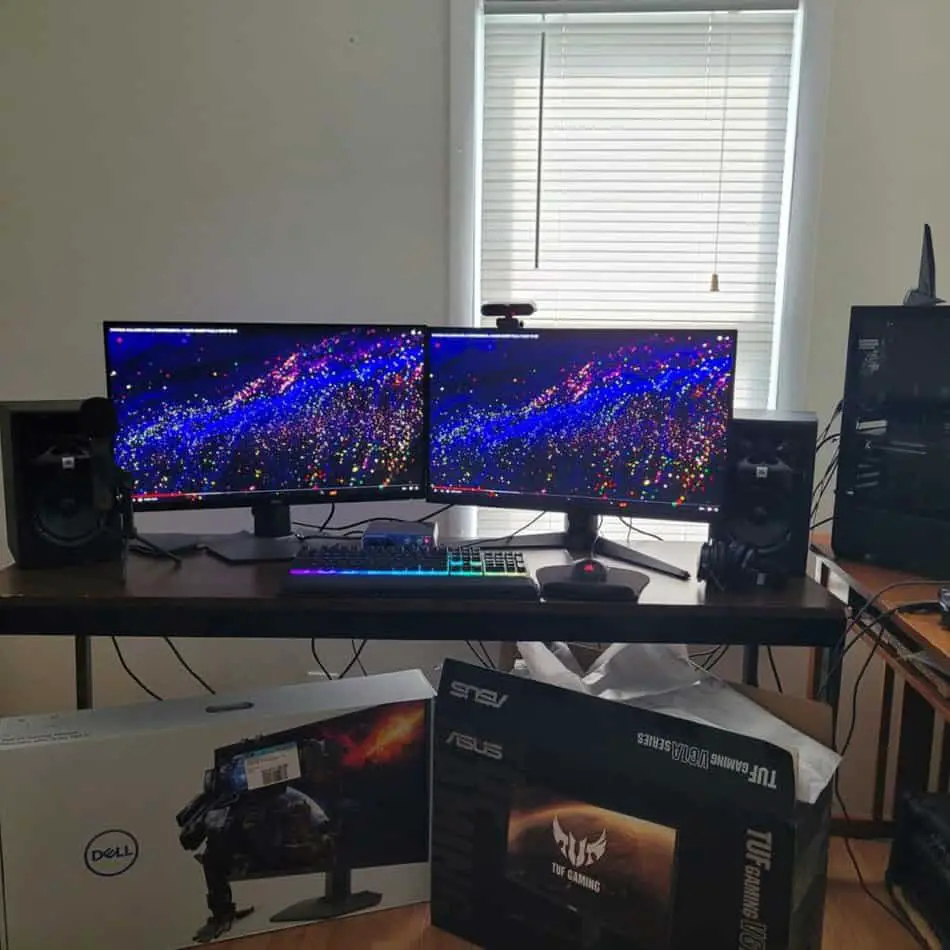
I’ve been a gamer and an office worker for several years now. I truly wish everyone knew the main differences between a gaming and non-gaming monitor because so many of my co workers and gamer friends struggle to get their money’s worth.
Among all the information on the web, I’ll explain everything, as simple and quickly as possible so you can forever make informed decisions about what type of monitor is perfect for your needs!
What’s the difference between gaming monitors and regular monitors?
Gaming monitors, unlike regular monitors, have higher refresh rates, response times, and lower input lag to give players a competitive edge and make graphics move in real-time. Regular monitors often provide better resolution for static images but don’t process video images as quickly and realistically.
7 Main Differences Between a Gaming Monitor and Regular Monitor
1. Refresh rates are better with gaming monitors
Gaming monitors typically have a refresh rate of 144hz to 240hz. Regular monitors have refresh rates at 30-60hz. Refresh rate is how fast a monitor is updating its screen. The more frequently a monitor updates its screen, the smoother the video images become when they move.
This is the most critical feature for people who play competitive games because it allows players to aim smoothly and effectively when playing games like Call of Duty or Halo Infinite. Any screen lagging from using a regular monitor could cost them points or a delayed reaction to an opponent’s movement.
For non-gamers, a regular 60hz monitor (i.e 60 frames per second) makes video image movement on a screen appear “real-time.” After playing video games on a regular monitor, you’ll eventually notice a difference between 60zh and 144hz.
2. Non-gaming monitors have poor response time
Input lag is how many milliseconds it takes for your screen to respond to you pressing a button or moving the joystick to orient your video game character.
Most gaming monitors will have a response time of 5ms or faster. Anything lower than 10ms is good enough for competitive gaming if you have a refresh rate greater than 75hz.
“Even though you can use a gaming monitor for normal work, there’s some key differences and it depends on your job profession.“
— Julian S, Photographer and Media Editor
Regular monitors have response times as slow as 15ms but their purpose is for static image editing or basic office work like typing or powerpoint.
3. Gaming monitors sacrifice resolution for smooth image speed
Competitive gamers often want smooth image processing over stunning graphical appeal because the higher the graphics and pixels on a screen, the higher the demand is on processing each image every second.
Gaming monitors and regular monitors can both come in the same resolutions (1920 x 1080, 1440 x 2560, 4k) but competitive gamers will usually opt for a low-end resolution option like 1920 x 1080p. You can buy a regular 4k monitor that isn’t meant for gaming because it lacks a high refresh rate (144hz or greater) or you can buy a low resolution monitor with high refresh rate that’s meant for gaming.
Important Note: If you like to play single player open world games with high resolution, you may want to double check if a 4k monitor is still right for you.
4. Gaming monitors are often smaller in size
Gamers who play competitive online games will get a smaller monitor to reduce its overall cost. Regular monitors are often larger to allow for windows multitasking and office or school work.
Average sizes for both gaming and regular monitors starts at 24 inches and can get as large as 49 inches such as the Samsung Galaxy Gaming Monitor.
There’s specific reasons a gamer might select a 24 inch, 27, inch and even 32 inch gaming monitor. Remember, gamers want high refresh rate, so the less pixels / screen size a monitor has to display every second, the more processing power can be allocated towards providing that smooth image.
5. Non-gaming monitors don’t rely on G-Sync

Gaming monitors utilize this feature to ensure the framerate of the monitor doesn’t get too far ahead of the PC’s graphics card’s ability to process it. If you played a 240hz game with a low end graphics card without G-Sync, you’ll see something called “screen tearing,” where the frames on the screen lag or disrupt the fluid movement of your image.
Office monitors don’t have G-Sync because they aren’t designed to support the demand of high speed graphical processing. Even if you’re just watching Youtube on your work’s monitor, you don’t need to worry about screen tearing on rendered video that’s already been processed for smooth image motion.
6. Gaming monitors are designed for style

Regular monitors for office work places don’t come with random RGB (red green blue) lighting and other features to make them look cool. Gaming monitors are designed with more style to fit people’s game room themes.
Gamers don’t mind paying a little bit more for LED background lighting or stylish design.
7. Gaming monitors cost more per square inch
Gaming monitors on average, are more expensive $150-250 than non-gaming monitors. The average price of a 144hz gaming monitor starts at $170 even for 1080p resolution.
Non-gaming monitors might be more expensive if you get one with 4k resolution even if it has a standard 60hz refresh rate.
Unfortunately there’s so many knock-off gaming monitors that makes it hard to know which one to get. Through my mistakes in buying several monitors, I finally learned how to get my money’s worth towards the features that matter.
4 Similarities between gaming monitors and regular monitors
1. Both gaming and non-gaming monitors can perform normal tasks
Gaming monitors are also great for normal office work for several job professions. This is because they operate just like a normal display when not playing games. I thought for the longest times gaming monitors were only able to boot up video games when they turned on but that’s not the case at all.
Both regular monitors and gaming monitors can surf the web and display anything on your PC. Just remember regular monitors aren’t good for video games, but aside from that these two types of monitors can do everything else.
2. Gaming and non-gaming monitors can have built-in speakers
In all the research I did, built-in speaker quality was the same between gaming and non-gaming products. I personally recommend this type of speaker setup for gaming and office work. Built in speakers for gaming monitors and office monitors are both low quality (5 watts).
3. Gaming and non-gaming monitors weigh the same on average
Both gaming monitors and regular monitors usually weigh the same. The only factor affecting weight is screen size.
Most monitors weigh 8-15lbs for 24-27 inch screens. There’s a small amount of gaming monitors that come with built in cooling fans which makes them heavier than average. However, you won’t usually find this feature in most gaming monitors.
If you travel a lot for work or want a more portable setup, you can check out this article here regarding gaming monitor weight and the ones we recommend.
4. Gaming and non-gaming monitors have standard HDMI ports
All modern monitors whether they’re built for gaming or not, will have standard HDMI or power adapter inputs. Some old non-gaming monitors might have VGA inputs as well but even office workers these days use the same HDMI cables that gamers use.
Related Questions
Is a 60hz regular monitor good for gaming?
A 60hz gaming monitor is exceptional for casual, single-player, story driven games or for players on a budget. A 6ohz monitor will still display smooth, consistent image quality. Here’s the best way to decide if 60hz is enough for the games you intend to play.
The video below is a non-gaming 60hz monitor compared to a 144hz and 240hz monitor:
On average, 60hz monitors are considered entry level and cost $60-100 less than 120hz and 144hz gaming monitors. Fast paced games like racing and first person shooter games will perform better on monitors with refresh rates higher than 60hz.
If you can afford, I highly recommend getting a monitor that is no less than 75 Hz. At this refresh rate and above, you won’t have to think twice about jumping into more demanding games should you see that happening in the future.
How smoothly your games run will also depend on the hardware of your gaming PC. If you have a graphics card such as a GTX 1070 or equivalent, and you’re gaming on a 1080p monitor, your PC is going to absolutely crush any games in terms of graphics and smoothness.
What monitors do professional gamers use?
Professional gamers use a wide variety, but their gaming monitors all have very similar specs. I found an article and I pulled a couple of famous gaming teams from around the world. Take a look below to see which ones each of the teams use.
Liquid: Alienware 25AW25
1ms response time, height-adjustable, tilt adjustable, 16:9 aspect ratio. The most advantageous thing about this one is the incredibly fast refresh rate. If you play a lot of FPS games and are really good at them already, then this monitor could make all the difference in a head to head match.
Draken: ASUS ROG Swift PG248Q
24 inches, 1ms response time. This one even comes with a blue-light filter to reduce the amount of eyestrain. You might not think this is a noteworthy feature, but think about how many hours professional gamers spend in front of a screen. Gaming sessions over 3 hours will strain the eyes if not taken care of. This won’t hinder your skills in any way.
* S1mple, Coldzera, NiKo all use a BENQ XL25 series! This actually surprised me a little bit. From a home theater standpoint, BENQ doesn’t make the best products for projectors but apparently they shine in the gaming monitor industry. Those teams are all foreign countries too so it’s interesting they still use an American company instead of a local one or any other brand.
What is the best budget monitor?
I can speak on this from personal experience and going off of what a lot of reviews say.
I actually did a video on my absolute favorite gaming monitor that I’ve used so far.
It was one of the first committed purchases I made for my gaming experience, and I’ve been using this one since. I haven’t felt the need to upgrade just yet because of how good of a quality it delivers. Check out the video if you’re interested. It’s the AOC Borderless series.
Final Thoughts
Deciding between a gaming monitor and a regular, non-gaming monitor does not need to be a complicated process. I know there’s a lot of information on the web, and I did my best to narrow down the essential information for you so you don’t have to spend more hours scratching your head on what the best choice is for you.
If this article helped you, or if you have any other questions, feel free to reach out and I’ll do my best to respond. I’m also taking article suggestions, so if you have those, you can reach me at entertainmentden.ns@gmail.com and I’ll do my best to respond.
